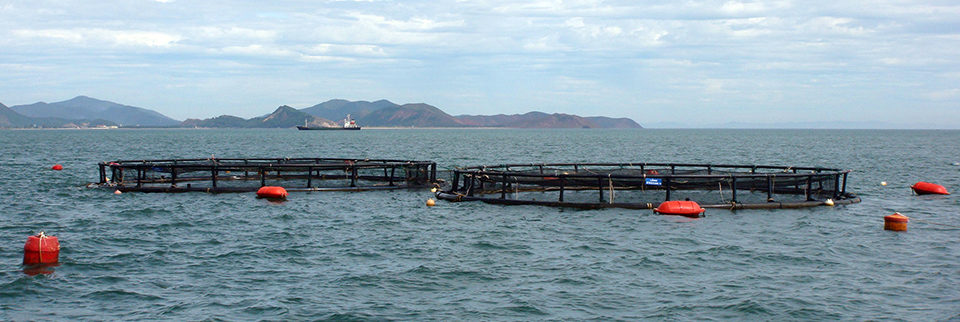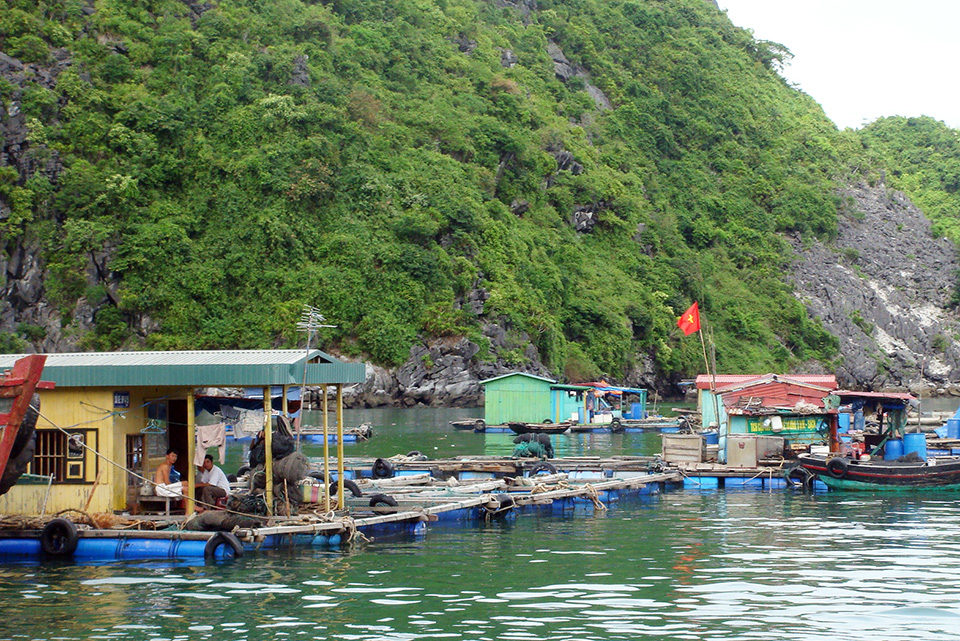Submergible cage design could support offshore culture

With a coastline more than 3,260 km in length, Vietnam has potential for marine aquaculture. However, Vietnam is exposed to tropical typhoons from the Pacific Ocean during autumn. Each year, seven to 10 storms that could affect marine fish-farming activities cross the coastal areas.
The government of Vietnam considers mariculture a priority in its overall strategy for marine economic development, but production is very limited. In 2011, farmed marine fish production was around 81,000 metric tons (MT) – equivalent to 3 percent of the total aquaculture output. Only 5,847 MT came from marine cage aquaculture. The development of appropriate technologies for marine fish farming are crucial to increase the marine aquaculture production.
Cultured species
To date, some two dozen indigenous marine finfish species have been considered for aquaculture. Fifteen of them are currently being farmed at different sites and different production scales in coastal areas of Vietnam.
The main cultured species are cobia (Rachycentron canadum), grouper (Epinephelus species), Asian sea bass (Lates calcarifer) and pompano (Trachinotus species), which have been artificially reproduced for seed production. The fish mostly serve local consumption, but part of their volume is exported to China and Japan.
Marine cages
Most small-scale marine farms in Vietnam use traditional wooden cages, while the industrial-scale farms tend to use floating, circular, high-density polyethylene (HDPE) net cages.
The wooden cage construction is simple, with typical rectangular frame dimensions of 3 by 3 meters. The cages are often assembled into “rafts” of four or more cages. Temporary huts can be constructed on top of the rafts to support daily operations.
These structures are very suitable for family-scale operation, and the cages can only be installed in the closed bays on the lee sides of the islands. Since the traditional cages are easily made but convenient for daily operation, their popularity had led to more than 16,300 cages, which contribute an annual production of around 3,500 MT.
In order to expand the farming areas and production, research on improvement of the traditional cages in Vietnam has been conducted since 2002. Several new designs with hexagonal or octagonal frames using wooden beams or flexible ropes and floats, and dynamic mooring systems have been tested at small scale with limited success.
HDPE cages
Introduction of the circular HDPE cages in Vietnam started in 1999 under a project co-funded by the governments of Norway and Vietnam. Two 9-meter-diameter, HDPE cages have been operated near Hon-ngu Island since 1999. These cages were moored with separate dynamic mooring lines that provided effective performance in the semi-open sea area. Cobia grown in the cages can reach 5 kg in a year, although their growth ceases during winter.
The successful introduction of the HDPE cages opened the possibility to expand cage culture volume and area. Since 2003, 22 HDPE cages have been installed in north-central Vietnam. In the southern region, Nha Trang Pearls Ltd. started farming marine fish (mainly cobia) in the HDPE cages in 2003, followed by An-hai Ltd. in 2005 and Marine Farms ASA Co., Ltd. Vietnam in 2006.
Marine fish production from the HDPE cages has been increasing dramatically. The estimated 550 MT of marine fish production from HDPE cages in 2008 increased to 1,600 MT in 2009 and recently reached around 2,300 MT.

Challenges
The major challenge for marine fish farming in Vietnam is a lack of appropriate cage technology for offshore culture. Production of marine fish at small-scale farms is limited by the rearing areas, and offshore farming is a good solution for future development of mariculture.
Large-scale farms in open-sea areas have been shown to improve growth and survival of fish, and reduce their visceral fat content compared to that of fish farmed in inshore areas. However, cages installed in the open sea can also be exposed to harsh weather conditions.
In 2005, a severe storm across north-central Vietnam destroyed most of the marine facilities, including the HDPE cages. The failure of the HDPE floating net cages in this region revealed the need for further improvement, especially as storm frequency and intensity seem to be increasing with climate change.
The other main challenge for marine fish farming in Vietnam relates to a shortage of appropriate formulated feed. Small-scale farms mainly feed trash fish, which is a very unstable provision with varied quality that can cause environmental pollution. The large-scale farms are using extruded pellets, but their feed-conversion ratios are relatively high (1.7 to 2.5 during grow-out). In addition, high feed cost is an obstacle for further development.
Submergible cages
Appropriate cage technology will be crucial for future development of offshore culture. After the failure of the HDPE cages in 2005, the mooring systems were improved to withstand the extreme conditions in the open sea, which will be essential to reduce the risks of marine fish farming.
Since 2007, a National Research Project has been conducted at the Research Institute for Aquaculture No. 1 with a focus on the development of submergible cages for offshore fish farming. The cage structure of the earlier HDPE floating cages was modified with collar rings and brackets for the new VISCOC-01 cages. The floating collars were equipped with special valve modules, and the cages were moored in a dynamic mooring system. This design allows the cages to sink or float by using only an air compressor control. As a result, the cages can be temporary submerged during stormy conditions to avoid surface damage.
Production-scale trial
In 2010, two, 1,200-cubic-meter cages featuring the new design were successfully installed near Hon-ngu Island in Nghe-an Province for a farm trial. The objective of the trial was to test cage and fish performance under real conditions at the commodity production scale.
Graded cobia with an initial average weight of 2.2 kg were stocked in the cages and fed extruded pellets once a day. Checked monthly, the growth of the fish is shown in Table 1.
Can, Growth of cobia, Table 1
| Stocking | Month 1 | Month 2 | Month 3 | Month 4 | Average | |
|---|---|---|---|---|---|---|
| Body weight (kg) | 2.20 ± 0.2 | 2.57 ± 0.13 | 3.47 ± 0.33 | 4.35 ± 0.61 | 5.13 ± 0.25 | |
| Specific growth rate (%/day) | 0.52 ± 0.22 | 0.99 ± 0.16 | 0.72 ± 0.14 | 0.97 ± 0.02 | 0.78 ± 0.01 | |
| Absolute growth rate (g/day) | 12.20 ± 4.26 | 29.85 ± 7.07 | 28.49 ± 8.73 | 46.00 ± 3.41 | 27.05 ± 2.08 |
The cobia grew very well to 6.0-kg size with an average specific growth rate of 0.78 percent/day, survival of 98.6 percent and feed-conversion ratio of 1.78 for the four months of rearing. In addition, the cobia showed good performance under temporary submerged condition at a depth of 6 m. Table 2 compares the performance of the VISCOC-01 cages to that of other systems.
Can, Comparison of cobia, Table 2
| VISCOC-01 Cages | Hexagonal Cages | Hexagonal Cages (Nguyen et al., 2008) | Hexagonal Cages (Nguyen et al., 2008) | |
|---|---|---|---|---|
| Cage volume (m3) | 1,200 | 40 | 40 | 40 |
| Rearing size (kg) | 2.2-5.1 | 2.5-4.0 | 1.2-3.7 | 3.7-6.8 |
| Specific growth rate (%/day) | 0.78 | 0.80 | 0.60 | 0.50 |
| Absolute growth rate (g/day) | 23.90 | 22.40 | 12.00 | 26.00 |
| Feed-conversion ratio | 1.78 | 2.5 | 1.8 | 2.0 |
In July 2011, the cages were affected by the storm Chanthu, which passed near the testing area. The two cages with fish inside were submerged for 45 hours without feeding, and the surface wind speed was measured up to 20 m/second. No problem with the cage systems or fish mortality was detected.
Perspectives
While the newer cages are performing well, more research on the system and the application of support equipment such as automatic devices for monitoring daily operation and maintenance is recommended. The development of related technologies, including feed and feeding technology, artificial fingerling production, post-harvest and processing technology, and marketing will also be very important in supporting sustainable marine aquaculture development in Vietnam.
(Editor’s Note: This article was originally published in the July/August 2012 print edition of the Global Aquaculture Advocate.)
Authors
-
Dr. Nhu Van Can
Research Institute for Aquaculture No. 1
Dinh-bang, Tu-son
Bac-ninh, Vietnam[109,111,99,46,108,105,97,109,103,64,110,97,99,110,97,118,117,104,110]
-
Dr. Pham Anh Tuan
Directorate of Fisheries
Hanoi, Vietnam
Tagged With
Related Posts

Intelligence
A motive, and a market, for farmed fish in Mexico
Boasting ample areas for aquaculture and a robust domestic demand for seafood – not to mention its close proximity to the U.S. market – a land of opportunity lies in Mexico. Fish farming is primed to meet its potential south of the border.

Health & Welfare
Advances in yellowtail larval rearing
The University of the Canary Islands in Spain is researching yellowtail broodstock management and larval rearing to promote aquaculture diversification in Europe.

Innovation & Investment
Investors see (mostly) upsides in aquaculture’s outlook
Aquaculture is attractive to investors, but they remain wary of diseases that could stunt projections of massive growth. At the IntraFish Seafood Investors Forum in New York, discussion about the salmon industry and its challenges — antibiotics, genetically modified fish, Chile’s woes, sea lice — revealed both criticism and optimism.

Responsibility
Aquaculture Exchange: Alan Shaw, Calysta
Turn fuel into animal food? Calysta can do that. The California biotech company is now hoping for greater buy-in from aquaculture, its target market. CEO Alan Shaw talks about the potential of FeedKind and its ambitious plans for 2016 and beyond.


